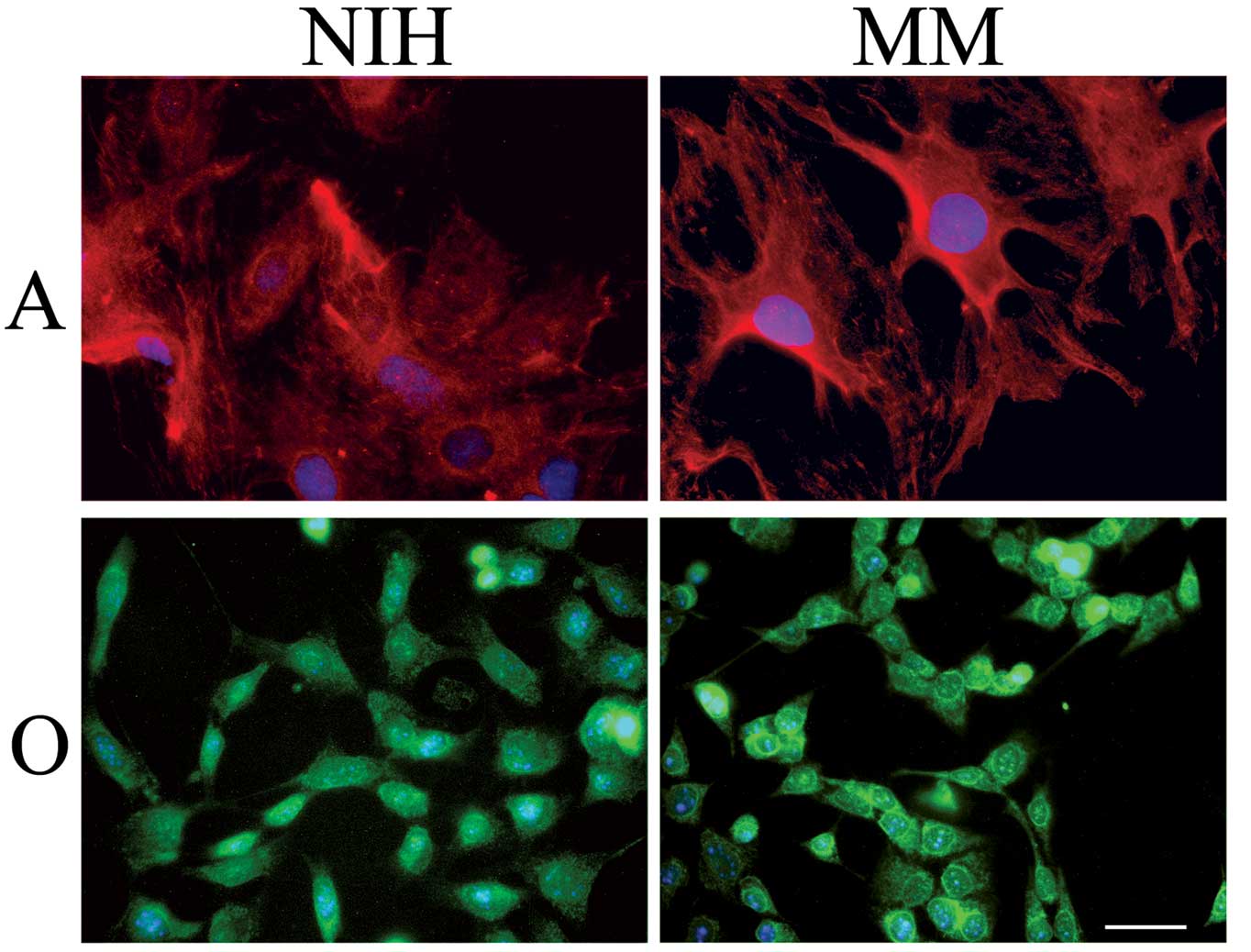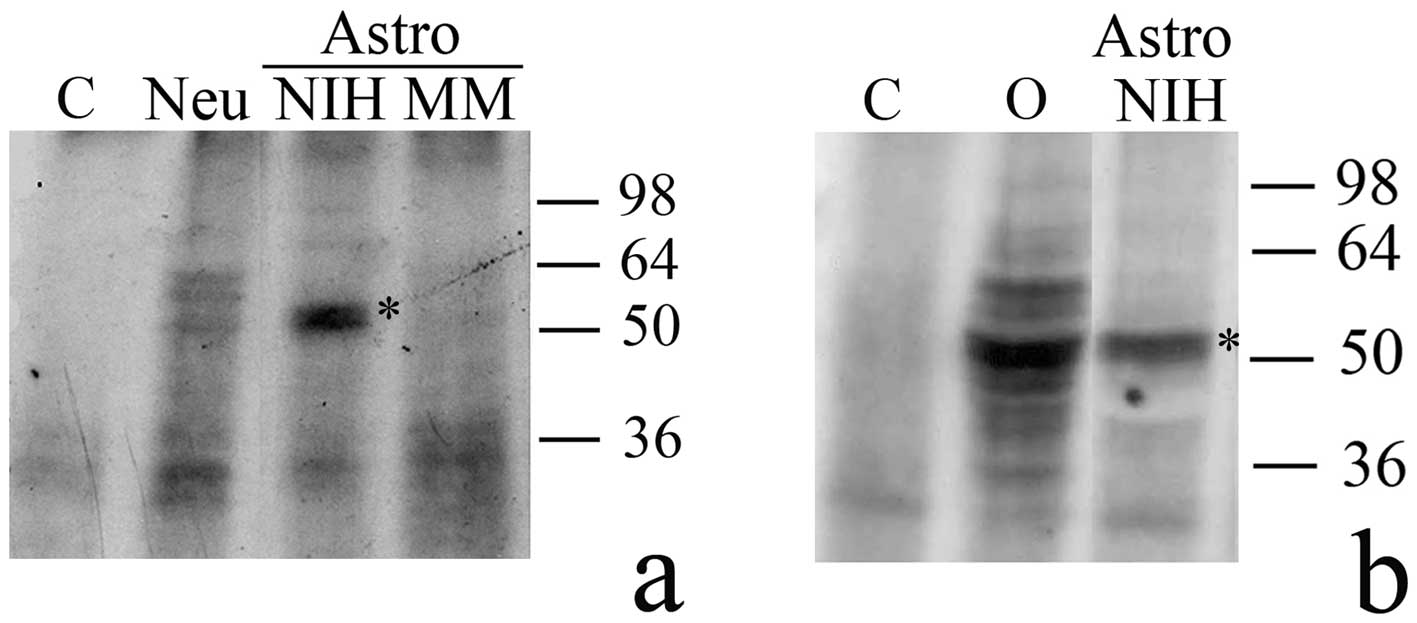|
1.
|
Allan J, Hartman PG, Crane-Robinson C and
Aviles FX: The structure of histone H1 and its location in
chromatin. Nature. 288:675–679. 1980. View
Article : Google Scholar : PubMed/NCBI
|
|
2.
|
Bates DL, Butler PJ, Pearson EC and Thomas
JO: Stability of the higher-order structure of chicken-erythrocyte
chromatin in solution. Eur J Biochem. 119:469–476. 1981. View Article : Google Scholar : PubMed/NCBI
|
|
3.
|
Huang HC and Cole RD: The distribution of
H1 histone is nonuniform in chromatin and correlates with different
degrees of condensation. J Biol Chem. 259:14237–14242.
1984.PubMed/NCBI
|
|
4.
|
Hill DA: Influence of linker histone H1 on
chromatin remodeling. Biochem Cell Biol. 79:317–324. 2001.
View Article : Google Scholar : PubMed/NCBI
|
|
5.
|
Fan Y, Nikitina T, Zhao J, Fleury TJ,
Bhattacharyya R, Bouhassira EE, Stein A, Woodcock CL and Skoultchi
AI: Histone H1 depletion in mammals alters global chromatin
structure but causes specific changes in gene regulation. Cell.
123:1199–1212. 2005. View Article : Google Scholar : PubMed/NCBI
|
|
6.
|
Crane-Robinson C: How do linker histones
mediate differential gene expression? Bioessays. 21:367–371. 1999.
View Article : Google Scholar : PubMed/NCBI
|
|
7.
|
Izzo A, Kamieniarz K and Schneider R: The
histone H1 family: specific members, specific functions? Biol Chem.
389:333–343. 2008. View Article : Google Scholar : PubMed/NCBI
|
|
8.
|
Marzluff WF, Gongidi P, Woods RK, Jin J
and Maltais LJ: The human and mouse replication-dependent histone
genes. Genomics. 80:487–498. 2002. View Article : Google Scholar : PubMed/NCBI
|
|
9.
|
Happel N and Doenecke D: Histone H1 and
its isoforms. Contribution to chromatin structure and function.
Gene. 431:1–12. 2009. View Article : Google Scholar : PubMed/NCBI
|
|
10.
|
Kowalski A and Palyga J: Linker histone
subtypes and their allelic variants. Cell Biol Int. 36:981–996.
2012. View Article : Google Scholar : PubMed/NCBI
|
|
11.
|
Clausell J, Happel N, Hale TK, Doenecke D
and Beato M: Histone H1 subtypes differentially modulate chromatin
condensation without preventing ATP-dependent remodeling by SWI/SNF
or NURF. PLoS One. 4:e00072432009. View Article : Google Scholar : PubMed/NCBI
|
|
12.
|
Fan Y, Sirotkin A, Russel RG, Ayala J and
Skoultchi AI: Individual somatic H1 subtypes are dispensable for
mouse development even in mice lacking the H1(0) replacement
subtypes. Mol Cell Biol. 21:7933–7943. 2001. View Article : Google Scholar : PubMed/NCBI
|
|
13.
|
Yang SM, Byung JK, Norwood Toro L and
Skoultchi AI: H1 linker histone promotes epigenetic silencing by
regulating both DNA methylation and histone H3 methylation. Proc
Natl Acad Sci USA. 110:1708–1713. 2013. View Article : Google Scholar : PubMed/NCBI
|
|
14.
|
Zlatanova J and Doenecke D: Histone H1
zero: a major player in cell differentiation. FASEB J. 8:1260–1268.
1994.PubMed/NCBI
|
|
15.
|
Gabrilovich DI, Cheng P, Fan Y, Yu B,
Nikitina E, Sirotkin A, Shurin M, Oyama T, Adachi Y, Nadaf S,
Carbone DP and Skoultchi AI: H1° histone and differentiation of
dendritic cells. A molecular target for tumor-derived factors. J
Leukoc Biol. 72:285–296. 2002.
|
|
16.
|
Castiglia D, Cestelli A, Scaturro M,
Nastasi T and Di Liegro I: H1° and H3.3B mRNA levels in developing
rat brain. Neurochem Res. 19:1531–1537. 1994.
|
|
17.
|
Scaturro M, Cestelli A, Castiglia D,
Nastasi T and Di Liegro I: Post-transcriptional regulation of H1°
and H3.3 histone genes in differentiating rat cortical neurons.
Neurochem Res. 20:969–976. 1995.
|
|
18.
|
Burd CG and Dreyfuss G: Conserved
structures and diversity of functions of RNA-binding proteins.
Science. 265:615–621. 1994. View Article : Google Scholar
|
|
19.
|
Hentze MW: Translational regulation:
versatile mechanisms for metabolic and developmental control. Curr
Opin Cell Biol. 7:393–398. 1995. View Article : Google Scholar : PubMed/NCBI
|
|
20.
|
Siomi H and Dreyfuss G: RNA-binding
proteins as regulators of gene expression. Curr Opin Genet Dev.
7:345–353. 1997. View Article : Google Scholar : PubMed/NCBI
|
|
21.
|
Derrigo M, Cestelli A, Savettieri G and Di
Liegro I: RNA-protein interactions in the control of stability and
localization of messenger RNA (Review). Int J Mol Med. 5:111–123.
2000.PubMed/NCBI
|
|
22.
|
Castiglia D, Scaturro M, Nastasi T,
Cestelli A and Di Liegro I: PIPPin, a putative RNA-binding protein,
specifically expressed in the rat brain. Biochem Biophys Res
Commun. 218:390–394. 1996. View Article : Google Scholar : PubMed/NCBI
|
|
23.
|
Scaturro M, Nastasi T, Raimondi L,
Bellafiore M, Cestelli A and Di Liegro I: H1° RNA-binding proteins
specifically expressed in the rat brain. J Biol Chem.
273:22788–22791. 1998.
|
|
24.
|
Nastasi T, Scaturro M, Bellafiore M,
Raimondi L, Beccari S, Cestelli A and Di Liegro I: PIPPin is a
brain-specific protein that contains a cold-shock domain and binds
specifically to H1° and H3.3 mRNAs. J Biol Chem. 274:24087–24093.
1999.PubMed/NCBI
|
|
25.
|
Raimondi L, D’Asaro M, Proia P, Nastasi T
and Di Liegro I: RNA-binding activity of PIPPin requires the entire
protein. J Cell Mol Med. 7:35–42. 2003. View Article : Google Scholar : PubMed/NCBI
|
|
26.
|
Scaturro M, Sala A, Cutrona G, Raimondi L,
Cannino G, Fontana S, Pucci-Minafra I and Di Liegro I: Purification
by affinity chromatography of H1° RNA-binding proteins from rat
brain. Int J Mol Med. 11:509–513. 2003.
|
|
27.
|
Bono E, Compagno V, Proia P, Raimondi L,
Schiera G, Favaloro V, Campo V, Donatelli M and Di Liegro I:
Thyroid hormones induce sumoylation of the cold shock
domain-containing protein PIPPin in developing rat brain and in
cultured neurons. Endocrinology. 148:252–257. 2007. View Article : Google Scholar : PubMed/NCBI
|
|
28.
|
Sala A, Scaturro M, Proia P, Schiera G,
Balistreri E, Aflalo-Rattenbach R and Di Liegro I: Cloning of a
rat-specific long PCP4/PEP19 isoform (LPI). Int J Mol Med.
19:501–509. 2007.PubMed/NCBI
|
|
29.
|
Saladino P, Di Liegro CM, Proia P, Sala A,
Schiera G, Lo Cicero A and Di Liegro I: RNA-binding activity of the
rat calmodulin-binding PEP-19 protein and of the long Pep-19
isoform. Int J Mol Med. 29:141–145. 2012.PubMed/NCBI
|
|
30.
|
Di Liegro CM, Schiera G, Proia P, Saladino
P and Di Liegro I: Identification in the rat brain of a set of
nuclear proteins interacting with H1° mRNA. Neuroscience.
229:71–76. 2013.PubMed/NCBI
|
|
31.
|
D’Agostino S, Salamone M, Di Liegro I and
Vittorelli ML: Membrane vesicles shed by oligodendroglioma cells
induce neuronal apoptosis. Int J Oncol. 29:1075–1085.
2006.PubMed/NCBI
|
|
32.
|
Schiera G, Proia P, Alberti C, Mineo M,
Savettieri G and Di Liegro I: Neurons produce FGF2 and VEGF and
secrete them at least in part by shedding extracellular vesicles. J
Cell Mol Med. 11:1384–1394. 2007. View Article : Google Scholar : PubMed/NCBI
|
|
33.
|
Proia P, Schiera G, Mineo M, Ingrassia AM,
Santoro G, Savettieri G and Di Liegro I: Astrocytes shed
extracellular vesicles that contain fibroblast growth factor-2 and
vascular endothelial growth factor. Int J Mol Med. 2:63–67.
2008.PubMed/NCBI
|
|
34.
|
D’Asti E, Garnier D, Lee TH, Montermini L,
Meehan B and Rak J: Oncogenic extracellular vesicles in brain tumor
progression. Front Physiol. 3:2942012.PubMed/NCBI
|
|
35.
|
Corrado C, Raimondo S, Chiesi A, Ciccia F,
De Leo G and Alessandro R: Exosomes as intercellular signaling
organelles involved in health and disease: basic science and
clinical applications. Int J Mol Sci. 14:5338–5366. 2013.
View Article : Google Scholar : PubMed/NCBI
|
|
36.
|
Mathivanan S, Ji H and Simpson RJ:
Exosomes: extracellular organelles important in intercellular
communication. J Proteomics. 73:1907–1920. 2010. View Article : Google Scholar : PubMed/NCBI
|
|
37.
|
Lo Cicero A, Schiera G, Proia P, Saladino
P, Savettieri G, Di Liegro CM and Di Liegro I: Oligodendroglioma
cells shed microvesicles which contain TRAIL as well as molecular
chaperones and induce cell death in astrocytes. Int J Oncol.
39:1353–1357. 2011.PubMed/NCBI
|
|
38.
|
Deregibus MC, Cantaluppi V, Calogero R, Lo
Iacono M, Tetta C, Biancone L, Bruno S, Bussolati B and Camussi G:
Endothelial progenitor cell derived microvesicles activate an
angiogenic program in endothelial cells by a horizontal transfer of
mRNA. Blood. 110:2440–2448. 2007. View Article : Google Scholar : PubMed/NCBI
|
|
39.
|
Skog J, Würdinger T, van Rijn S, Meijer
DH, Gainche L, Sena-Esteves M, Curry WTJ, Carter BS, Krichevsky AM
and Breakefield XO: Glioblastoma microvesicles transport RNA and
proteins that promote tumour growth and provide diagnostic
biomarkers. Nat Cell Biol. 10:1470–1476. 2008. View Article : Google Scholar : PubMed/NCBI
|
|
40.
|
Lo Cicero A, Majkowska I, Nagase H, Di
Liegro I and Troeberg L: Microvesicles shed by oligodendroglioma
cells and rheumatoid synovial fibroblasts contain aggrecanase
activity. Matrix Biol. 31:229–233. 2012.PubMed/NCBI
|
|
41.
|
Cestelli A, Savettieri G, Ferraro D and
Vitale F: Formulation of a novel synthetic medium for selectively
culturing rat CNS neurons. Brain Res. 354:219–227. 1985. View Article : Google Scholar : PubMed/NCBI
|
|
42.
|
Schiera G, Bono E, Raffa MP, Gallo A,
Pitarresi GL, Di Liegro I and Savettieri G: Synergistic effects of
neurons and astrocytes on differentiation of brain capillary
endothelial cells in culture. J Cell Mol Med. 7:165–170. 2003.
View Article : Google Scholar : PubMed/NCBI
|
|
43.
|
Schiera G, Sala S, Gallo A, Raffa MP,
Pitarresi GL, Savettieri G and Di Liegro I: Permeability properties
of a three-cell type in vitro model of Blood-Brain barrier. J Cell
Mol Med. 9:373–379. 2005. View Article : Google Scholar : PubMed/NCBI
|
|
44.
|
Chomczynski P and Sacchi N: Single-step
method of RNA isolation by acid guanidinium
thiocyanate-phenol-chloroform extraction. Anal Biochem.
162:156–159. 1987. View Article : Google Scholar : PubMed/NCBI
|
|
45.
|
Bradford MM: A rapid and sensitive method
for the quantification of microgram quantities of protein utilizing
the principle of protein dye binding. Anal Biochem. 72:248–254.
1978. View Article : Google Scholar : PubMed/NCBI
|
|
46.
|
Castiglia D, Gristina R, Scaturro M and Di
Liegro I: Cloning and analysis of cDNA for rat histone H1°. Nucleic
Acids Res. 21:16741993.
|














